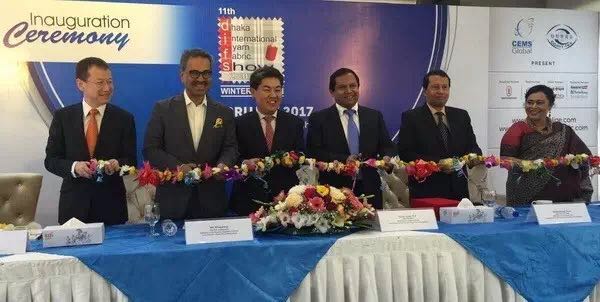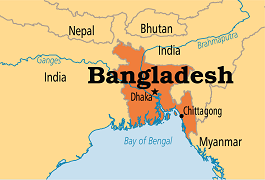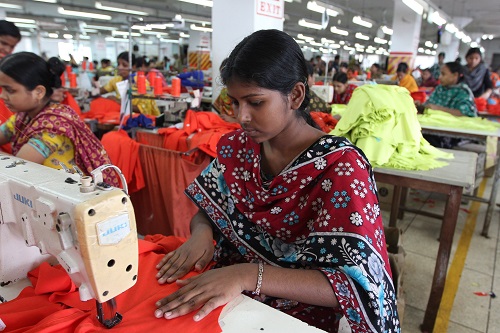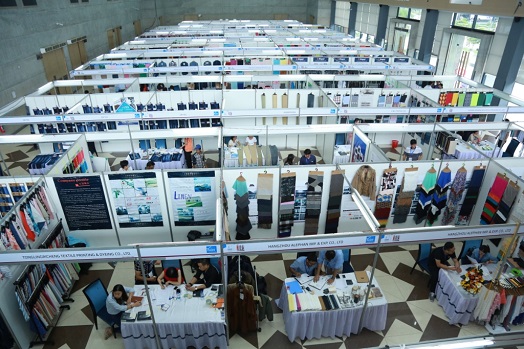Bangladesh: A new move from CCPIT TEX
Dhaka Int'l Yarn Fabric Show Winter Edition
Mar 01, 2017 | by Zhao Zihan

Dhaka Int'l Yarn Fabric Show (Winter Edition) (“2017 DIFS Winter”for short), a four-day event from February 15th to 18th, 2017 in International Convention City Bashundhara,Dhaka, Bangladesh, is also the first-edition show based on the cooperation between the Sub-Council of Textile Industry, China Council for the Promotion of International Trade (CCPIT TEX) and CEMS-Global.
With the enormous success of DIFS-Summer Edition and due to lack of spacing to accommodate exhibitors; CEMS-Global launches Winter Edition to give scope to all in order to focus on the $25 Billion Apparel Export Market of Bangladesh.
The “2017 DIFS Winter” is a one-stop large marketplace of Bangladesh for textile business as well as presenting the latest fabrics and trends. Over 130 exhibitors from such six countries as China, India, Sri Lanka, Bangladesh, Malaysia and Singapore presented their up-to-date fabrics, which are ready-to-use for garment, accessories, industrial use and other various applications. The “2017 DIFS Winter”was fully equipped with all ranges of textile products enhanced with the latest technology.
It is the first professional brand show in Bangladesh to chime in with the spring and summer procurement season, aiming to serve the growing garment export processing industry in Bangladesh. Meanwhile, it is also an important market initiative to implement what President Xi Jinping’s visit last year to Bangladesh has achieved. The exhibition has greatly facilitated a number of Bangladesh garment processing enterprises to purchase high-quality fabrics and accessories without going abroad.
In the morning, Ma Mingqiang, Chinese Ambassador to Bangladesh,Zhang Tao,Secretary General of CCPIT TEX, Mirza Azam, Minister of Ministry of Textiles and Jute of Bangladesh, Shubhashish Bose, Secretary in Charge of Ministry of Textiles and Jute of Bangladesh, and Faruque Hassan, Senior Vice President of Bangladesh Garment Manufacturers and Exporters Association (BGMEA) made speeches during the opening ceremony which was chaired by Meherun N. Islam, Chairman of CEMS-Global.
Ambassador Ma Mingqiang said in his speech that since October last year when President Xi Jinping visited Bangladesh, China-Bangladesh relation has been upgraded into a strategic partnership in order to promote the continuous development of bilateral relations at a higher level, as well as further deepened cooperation in bilateral economy, trade, and infrastructures. China’s textile industry has been in a leading position in the world. Ambassador Ma hopes that the international supplier status of the textile industry in Bangladesh will be further enhanced by the continued holding of the exhibition, and the supply chain of fabrics and accessories for garment manufacturing will be further optimized. At the same time, Chinese textile enterprises are encouraged to take the initiative to go abroad to have a better understanding of Bengal market investment environment, policies and regulations through the exhibition, looking for partners. Cooperation between the two countries is greater than competition. We will work together to provide better products and services for the global market,which is also the needs and guidance of national “Belt and Road Initiative”.
Mirza Azam stated in his speech that in recent decades, the textile and garment industry has been playing an increasingly important role in Bangladesh's economic development, and the industry has become the main driving force of national economic growth and export growth. In recent years, the external environment of the global textile industry has been facing constantly undergoing profound changes, while the traditional textile and apparel industry has been suffering increasingly fierce international competition. Therefore, the Bangladesh textile and garment industry is in urgent need to strengthen international exchanges and enhance industry innovation and competitiveness. The first Winter Edition brings together manufacturers, suppliers and buyers from around the world to build a platform for resource sharing and information exchange for Bangladesh textile and garment enterprises, conducive to carrying out in-depth international cooperation in the fields of talent, technology, capital and so on.
With the deepening of economic globalization and regional integration, bilateral cooperation in various fields is facing enormous opportunities. Bangladesh, as the second largest garment exporter after China, requires to import 75% of the woven fabrics needed. China and Bangladesh are highly complementary. Facing the global economic downturn and the weak international market demand, China’s garment fabrics exported to Bangladesh have always maintained a certain growth momentum in recent years.
According to official statistics of Bangladesh, at present, there are more than 2,000 textile mills, over 6,000 garment processing plants, and more than 4.8 million employees in Bangladesh. China’s textile exports to Bangladesh in 2006 were 5.17 billion USD, an increase of 4.41% from the same period of last year, while the textile imports from Bangladesh were 14.6 million USD, up 5.72% year-on-year.
Dhaka Int'l Yarn Fabric Show (Summer Edition) (DIFS Summer for short) is the largest professional exhibition of fabric and yarn in Bangladesh. It has been successfully held for 10 editions. Based on the brand effects of the Summer Edition, the Winter Edition is another choice for the exhibitors to seek for lower price in fabric supply.
Dhaka Int'l Yarn Fabric Show (Winter Edition) marks a new move that CCPIT TEX has made to provide targeted market services for fabric processing enterprises following New York City in the United States, Paris in France, Sao Paulo in Brazil, and Cape Town in South Africa. With the rising costs of labor and raw materials in China, as well as the sluggish external demand, the new competitive advantages have not yet come, CCPIT TEX is trying to guide enterprises to take the initiative to break the deadlock and break through the bottleneck, to find suitable development space and direction.

China and Bangladesh
China and Bangladesh formally established diplomatic relations on October 4th, 1975, and since then the two nations have been enjoying a rapid development of bilateral relation which was increasingly consolidated and strengthened in the political, economic and cultural fields. The exports from China to Bangladesh mainly include textiles (47.23%), machinery and transportation equipment (30.1%), chemical products (8.02%), metal and metal products (4.26%), steel (1.15%), and petroleum and petroleum products (0.47%), while China’s imports from Bangladesh are mainly leather and leather products (81.73%), textiles and related products (4.17%), frozen food (3.81%) and jute (2.66%).
Why Bangladesh?

The textile and clothing industries provide the single source of growth in Bangladesh's rapidly developing economy. Exports of textiles and garments are the principal source of foreign exchange earnings. By 2002 exports of textiles, clothing, and ready-made garments (RMG) accounted for 77% of Bangladesh’s total merchandise exports.By 2013, about 4 million people, mostly women, worked in Bangladesh's $19 billion-a-year industry, export-oriented ready-made garment (RMG) industry. Bangladesh is second only to China, the world's second-largest apparel exporter of western brands. Sixty percent of the export contracts of western brands are with European buyers and about forty percent with American buyers.Only 5% of textile factories are owned by foreign investors, with most of the production being controlled by local investors.
Bangladesh's textile industry has been part of the trade versus aid debate. The encouragement of the garment industry of Bangladesh as an open trade regime is argued to be a much more effective form of assistance than foreign aid. Tools such as quotas through the WTO Agreement on Textiles and Clothing (ATC) and Everything but Arms (EBA) and the US 2009 Tariff Relief Assistance in the global clothing market have benefited entrepreneurs in Bangladesh's ready-made garments (RMG) industry. In 2012 the textile industry accounted for 45% of all industrial employment in the country yet only contributed 5% of the Bangladesh's total national income.

In order to accelerate its economic development, the Government of Bangladesh attaches great importance to attracting foreign investment. The government has promulgated a series of financial and non-financial incentives and policies, including tax holidays, the abolition of all non-tariff barriers, and so on. In addition, Bengal currency is stable and inflation is low.
Despite the fierce international competition, Bangladesh can compete with any country in the textile and garment exports. Huge potential and market opportunities help the country's textile industry continue to grow year after year.
Why Dhaka International Yarn & Fabric Show ?
•DIFS is A Comprehensive Exhibition for Overseas Yarn, Fabric & Textile Manufacturers / Exporters focusing on the Textile & Apparel Industry of Bangladesh
•DIFS is targeted to the entire textile & garment sector of Bangladesh
•DIFS draws huge visitors from the textile & garment arena of Bangladesh, the biggest Export Exchange earning industry of Bangladesh with export of over US$ 12 Billion and requires to import over 75% Fabric (Woven) for the Garment export demand of over 6,000 Garment & Textile factories / mills of the country
•Bangladesh is investing over US$ 2 billion to upgrade their Textile & Garment sector
•The Textile and Garment Industry in Bangladesh Increased by 18.2% to Reach US$9.6bn
•Bangladesh has ranked 4th in the global apparel exports and grabbed 3 percent market share, according to a recent World Trade Organisation (WTO) report by exporting apparel items worth more than $10 billion
•Bangladesh Apparel exports have reached the US$ 12 Billion mark with Knitwear alone accounting for US$ 5.5 Billion in exports
•Bangladesh exported US$12.496bn worth of apparel worldwide in the 12-month period from July 2009 to June 2010. It accounted for 77% of the country’s total exports of US$16.204bn during the year
•Bangladesh was the largest exporter of cotton T-shirts and was 2nd for cotton pullover and jeans exports to European countries in 2009. In terms of volume, the country was the 2nd largest exporter of cotton trousers to the US last year.
•Bangladesh exported ready-made garments worth US$34.043 million during the July-December period of 2009-10
•Bangladesh is one of the country in South Asia leading the race for shaping up for the Textile & Apparel exports to the US & EU



